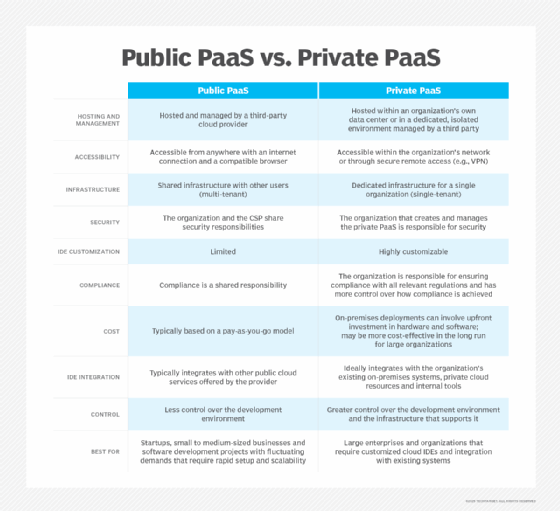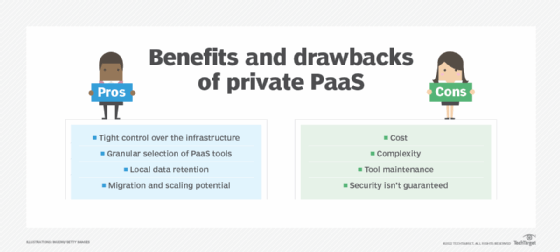What is private PaaS? How is it different from public PaaS?
Private platform as a service (private PaaS) is a cloud computing model that facilitates the development, deployment and management of software applications in a private cloud. Essentially, the private cloud component provides an IT infrastructure, and the PaaS component provides an application development and deployment platform that runs on top of it. Once deployed, a private PaaS provides an organization's developers with a dedicated software development environment that can be accessed through a web browser.
Private cloud PaaS services can be hosted in an organization's own data center or by a third-party cloud service provider (CSP). This flexibility allows organizations to choose which environment aligns best with their operational goals, compliance burden, budget and existing IT infrastructure.
Today, most private PaaS are deployed on private clouds managed by a CSP. This shift reflects practical considerations around cost and the complexity of managing IT infrastructure. Building and maintaining an in-house private cloud capable of supporting a private PaaS environment can require significant investments in hardware, software, physical facilities and skilled personnel. For many organizations, especially those focused on rapid application development and innovation, it makes more sense to use a private cloud service offered by a trusted provider.
Public cloud PaaS vs. private cloud PaaS
Platform as a service (PaaS) is a cloud computing model that provides users with a ready-to-use software development environment for building, testing and deploying applications. In public PaaS deployments, the cloud service provider is responsible for providing infrastructure and preconfiguring the development environment. This approach provides developers with a standardized development environment that can be purchased as a service and used immediately.
This article is part of
What is PaaS? Platform as a service definition and guide
In private PaaS deployments, however, the organization that will be using the PaaS is responsible for creating, deploying and managing the development environment. This approach allows organizations to not only customize how the platform is configured but also its security policies, compliance measures and integration with other systems.

What is private PaaS used for?
Private PaaS deployments are used by organizations to build, test, deploy and manage applications in a secure, customizable and controlled cloud environment. Popular use cases include the following:
Application development in regulated industries. Private PaaS is often used in healthcare, finance and government sectors by organizations that need to comply with strict regulatory compliance requirements. Private PaaS can be especially useful for organizations that have very granular requirements for working with financial data and personally identifiable information (PII) in the cloud.
Legacy system modernization. Large enterprises might use private PaaS to modernize their proprietary legacy applications. Legacy applications often run on specific, aging infrastructure that is difficult and costly to maintain and upgrade. A private PaaS can abstract the underlying infrastructure and allow developers to break down legacy applications into microservices over time.
Internal DevOps automation. Private PaaS provides a centralized platform for DevOps teams to automate CI/CD pipelines, manage microservices and standardize workflows across departments.
Custom infrastructure and application control. Organizations that have unique infrastructure requirements or need to enforce industry-specific security and privacy controls can use private PaaS to fully tailor their platforms and deployments.
Hybrid cloud enablement. Critical workflows and sensitive data can be hosted in the private PaaS environment, while less critical operations and data can be hosted in a public cloud.
Cost control. Even though private PaaS deployments hosted on-premises can require significant upfront infrastructure investments, they can lower long-term operational costs in large organizations by providing greater control over the development and operational environments.
Examples of private PaaS providers
While many leading cloud and enterprise technology companies offer PaaS services, only some offer the flexibility to deploy PaaS services within a dedicated, private cloud infrastructure, providing control and customization for specific business needs. They include the following:
Red Hat OpenShift. Known for its strong focus on containerization and Kubernetes.
VMware Tanzu Platform. Can be used in conjunction with VMware's private cloud offerings to provide a consistent platform for application development and deployment.
IBM Cloud Pak for Applications. An enterprise-grade platform for developing, managing and deploying container-based applications.
Jelastic Cloud. Offers a multi-cloud PaaS service that includes private PaaS options for enterprises.
Microsoft Azure Stack. Azure Stack offers a private cloud platform that can be deployed on-premises to provide a private PaaS environment.
AWS Virtual Private Cloud. AWS VPC provides logically isolated, dedicated network space inside the AWS public cloud infrastructure that can support a private PaaS.
OpenStack. A popular open source cloud platform that can be used to build a private PaaS environment.
Private PaaS for regulated industries
Private PaaS solutions are often employed by organizations in highly regulated industry sectors. Organizations in healthcare, finance and government sectors, for example, constantly balance how to accelerate application development and delivery without compromising compliance, security or control.
A private PaaS can provide organizations in these sectors with a controlled, customizable and isolated environment where they can enforce their own security policies, compliance frameworks and operational controls. Because a private PaaS is dedicated to a single organization and is not shared across multiple tenants like a public PaaS, it's much easier to implement the fine-grained security measures and auditing processes that regulatory standards often require.
Organizations who are considering hosting their private PaaS with a trusted third-party provider need to have a clear understanding of the provider's shared responsibility model, security and data residency policies, and compliance certifications. It's also important for organizations to evaluate the total cost of ownership. The right cloud provider can deliver long-term value through operational efficiency and reduced risk.
Increasingly, organizations in highly regulated industries are looking to reduce risk by using cloud service providers who offer industry clouds. An industry cloud combines standard cloud services (like compute, storage and databases) with prebuilt regulatory compliance controls, industry-specific data models, specialized workflows and security policies designed for that industry's standards.
Pros and cons of private PaaS
The trade-offs of private PaaS development, deployment and operations largely reflect the general benefits of using private cloud services and the challenges commonly associated with using PaaS services.
Here are some of the advantages of private PaaS:
- Private PaaS can be set up to meet the unique application lifecycle management (ALM) requirements of a specific organization.
- Organizations can customize the platform's configuration to meet the specific requirements of their applications. This can make it easier to control apps.
- Private PaaS rollouts can take advantage of a wide array of integrated development environments (IDEs), code repositories, testing tools and deployment options.
- Development tools, runtime environments and security settings in a private PaaS can be customized to align with an organization's internal governance policies and best practices.
- Organizations have the choice of hosting private PaaS services in-house or with a third-party CPS. Having the two options can help an organization comply with relevant compliance regulations for data sovereignty.
- Private PaaS deployments provide developers with a structured, container-friendly environment that can simplify the migration of legacy applications.
- On-premises private PaaS deployments can extend scaling to public cloud resources while maintaining sensitive workloads in a private environment.

Here are some of the challenges of private PaaS:
- Compared to public PaaS, which is ready to use out of the box, private PaaS requires the environment to be developed before developers can start using it productively.
- Setting up a private PaaS can take weeks or months, unlike public PaaS solutions that are available on demand.
- Implementing and deploying a private PaaS can be complicated and require deep DevOps expertise.
- Managing private clouds requires personnel who have the skills to build, operate and maintain the environment.
- Scalability is dependent on available on-premises resources or by the capacity of a third-party's dedicated infrastructure.
- Creating and deploying a private PaaS in-house typically requires an organization to purchase additional hardware and software licenses.
- While private PaaS offers more control over security configurations compared to public PaaS, the actual level of protection depends on how the platform is configured, maintained and monitored by the organization or its service provider.
Learn the basics of cloud management and why the requirements for managing different types of cloud services can vary dramatically across organizations.






